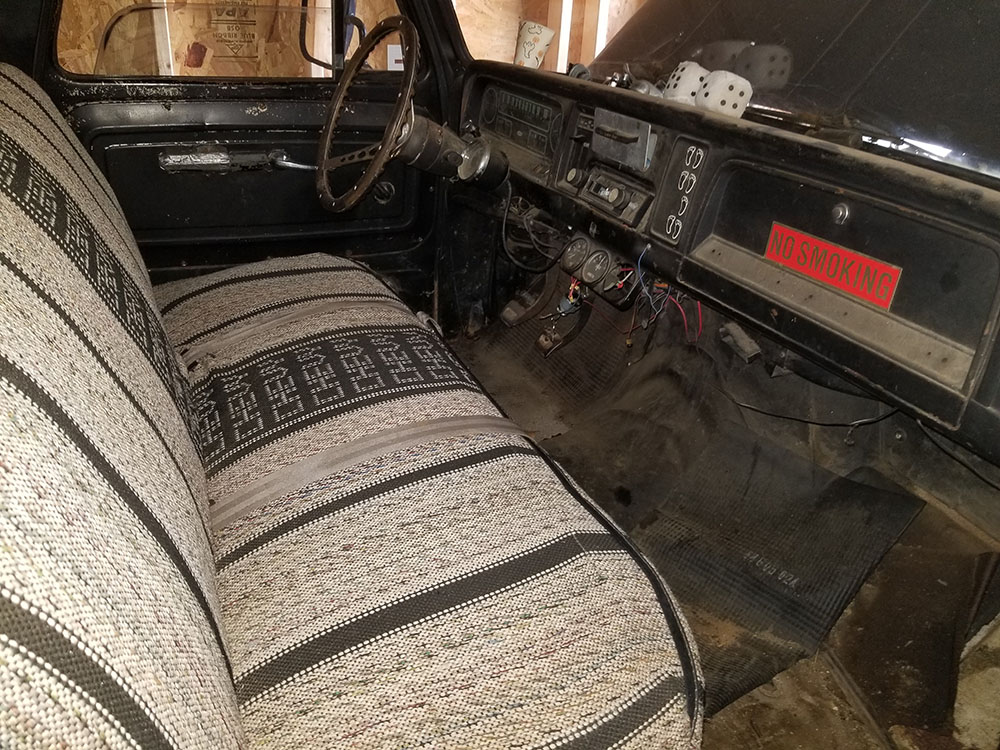LAST EDITED ON Feb-14-25 AT 00:15 AM (EST)
I did a thing yesterday that was cool as heck... and got so into it I forgot to take any photos. (facepalm)Anyway, remember this?

As with a lot of cars of its era, the '63–'66 Chevy pickup instrument cluster comes out as a single sub-assembly. There were two versions in 1966: this one, which has a row of gauges below the speedometer, and one that only has indicator lights for everything other than fuel level.
The gauges, from left to right:
1. coolant temperature; pretty self-explanatory
2. the manual claims this is an ammeter, but the way it's marked, it must really be a voltmeter. it shows whether the battery is being charged or discharged, which in practice really means it shows whether the voltage at the battery is greater or less than 12 volts DC
3. oil pressure; again, kinda explains itself
4. fuel
I can't remember if any of Angus's original gauges worked. I think the gas gauge did, but the others... well, we installed that package of aftermarket gauges that used to be in there for a reason.

(visible below the radio in this pic from back during Project Impala in 2019. we had already stolen the oil pressure gauge out of the set for temporary use in the Impala when I took that photo)
The round dummy gauges to left and right of the speedometer are blanks where different things would be in different versions of the cluster. In the indicator-lights version, the one on the left has two coolant temp lights, COLD and HOT, and the right one has a bigger, round fuel gauge. In place of the lower gauges, the left panel has a light that comes on if the generator* isn't charging, and the right one is a low-oil-pressure light.
In this version of the cluster, the round panel on the left was never anything but a blank, but there was an optional tachometer that replaced the blank on the right. There's a company that makes a reproduction kit of the stock tach, and I'm very tempted, but it's kind of expensive...
Anyway, that's presumably more than you ever wanted to know about a 1966 Chevrolet pickup instrument cluster. Point is, after some reconnaissance, I took mine apart. There's a lot of neat stuff about how it goes together, but... I forgot to take pictures, so... maybe next time.
In the meantime, my plan is to clean up the structural parts--as you might expect, they're very dusty, even on the inside. The assembly is, after all, almost exactly 60 years old. There's a date stamped on the back of the main body casting, which I assume is when it was originally assembled: January 18, 1965.
Once everything's clean, I should try to find out if there's any way of testing automotive gauges when they're not in a working car. If not, I'll have to just put it back together and we'll find out whether any of them work once we've got an engine in there. Then we'll have to decide whether to buy replacements (like the tach kit, there are suppliers that sell repro internals for the stock gauges), put back a set of aftermarket gauges... or possibly both.
There are actually solid arguments for that last course of action, weird as it sounds. The stock gauges aren't really very informative at all. The temperature gauge, for instance, doesn't actually tell you the, uh... the temperature of anything. Its only calibration is relative:
C / H
OK, so, it's "hot". How hot? How close are we to boiling the radiator? This is important information, but it's just... not there. They're all like this--the bare minimum of information, not really much better than a warning light. To be fair, they had to be designed for the panel they're in, and that means they can't be big enough to show much more than they do.
So I'm tempted to get them working for authenticity's sake, if possible, and run a set of newer ones elsewhere on the dash (probably where the old set was) that provide more helpful detail.
Either way, cleaning first. Next time I'm in the shop I'll try to remember to lay the bits out and get some more informative pictures. There's an electrical sub-harness, too, that needs to have a bunch of light bulb sockets installed when the whole thing's reassembled. How they did the lights on this panel is kind of cool, too, so I want to try to give a better idea of how they did that.
--G.
* by 1966 they were alternators, but GM still called them generators
-><-
Benjamin D. Hutchins, Co-Founder, Editor-in-Chief, & Forum Mod
Eyrie Productions, Unlimited http://www.eyrie-productions.com/
zgryphon at that email service Google has
Ceterum censeo Carthaginem esse delendam.


 Session 1
Session 1
 RE: Session 1
RE: Session 1
 RE: Session 1
RE: Session 1
 RE: Session 1
RE: Session 1 Session 2
Session 2
 Session 1A
Session 1A
 RE: Session 1A
RE: Session 1A RE: Session 1A
RE: Session 1A RE: Session 1A
RE: Session 1A sessons... 3 through 5? ish
sessons... 3 through 5? ish
 RE: sessons... 3 through 5? ish
RE: sessons... 3 through 5? ish RE: sessons... 3 through 5? ish
RE: sessons... 3 through 5? ish
 dang it
dang it
 session 6
session 6
 RE: session 6
RE: session 6
 RE: session 6
RE: session 6 RE: session 6
RE: session 6
 session 7
session 7
 RE: session 7
RE: session 7 RE: session 7
RE: session 7 session 8
session 8
 Printer-friendly copy
Printer-friendly copy





